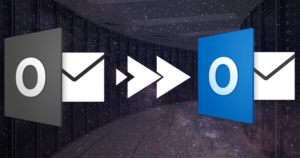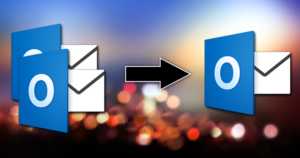Are you looking for a guide to help you choose which is better: New Outlook vs Old Outlook? Microsoft Outlook is a worldwide famous and most in use email client. It allows businesses or users to manage their emails, contacts, and calendar entries. Moreover, MS Outlook comes with a user-friendly GUI that gives users better access to their essential emails, contacts, calendars, and other data.
This blog will simply meet users’ requirements and give them a brief explanation so that they can differentiate nicely and choose the perfect one for their business work. Kindly engage with the blog until the end and get a detailed guide on New Outlook vs Classic Outlook offered by Microsoft.
What is New Outlook? A Brief Introduction!
The Microsoft New Outlook is a free email client to manage emails, calendars, and contacts and collaborate better. This email client is an improvised version of Old or Classic Outlook. It has new and better integrating features so that users or businesses can efficiently work on it along with other Microsoft 365 productive applications. It is a desktop version of Outlook but also offers web-based Outlook features to the users.
The New Outlook comes with a lot of advanced features and supports multiple email accounts, including Microsoft, Gmail, iCloud, etc. It also offers a unified inbox for various email clients in one place. Let us keep an eye on its highlighted features.
Key Features of the New Outlook
- It has a more intuitive interface, designed for better productivity and ease of use for businesses or individuals.
- Moreover, users can manage all their email accounts in one place using Microsoft New Outlook on their desktop.
- This new Outlook for Windows includes various AI-powered tools, such as meeting insights, category suggestions, and integration with other Microsoft 365 apps.
- It runs faster and smoother than the previous or old versions of Outlook for Windows.
- Businesses and individuals can work collaboratively with Microsoft productive applications, like OneDrive, MS Team, Excel, etc.
Besides that, users will also get other user-centric facilities to make their communication and collaboration seamless. Now, we will move to the upcoming section and understand the need for the Old Outlook along with its simple benefits.
Why Old Outlook or Classic Outlook still matters in 2025?
Old Outlook or Classic Outlook is very beneficial for users. It is a desktop-based email client and allows users to have offline access to their emails, contacts, calendars, etc. Moreover, the reason why Old Outlook still matters is that it offers better data-saving facilities in two data files: OST and PST.
Outlook OST File:
It saves data in the OST file when the Exchange Cached Mode is enabled, which users can easily access even without an internet connection. Most importantly, it syncs the data to the server from offline OST when users connect to the internet.
Outlook PST File:
Classic Outlook uses PST file format to save users’ data when they use the POP3 account to configure Outlook. Moreover, the PST file is also used by Outlook to backup or archive emails and store old emails separately from the server. Unfortunately, these services are not available in the New Outlook, and old Outlook is still the first preference for most users in the world.
The benefits of OST and PST files are that they help users save their data from future mishaps, like accidental data loss, etc. These files work as a backup of the users’ data in the local drive. We hope you now understand why users still rely on Old Outlook.
Now, let us jump to the new paragraph and compare the old Outlook with the new Outlook.
Comparison between New Outlook vs Old Outlook (Classic Outlook)
This section will give you a detailed view of the features of Old and New Outlook email clients. That makes it easy for users to identify which is a better solution for their productive work. We will use a simple table to understand the key differences between New Outlook and Old Outlook email clients.
| Features | New Outlook for Windows | Old Outlook for Windows |
|---|---|---|
| User Interface | Simple user interface and aligned with Outlook Web. | Traditional and feature-rich but sometimes cluttered. |
| Performance | Lighter and faster as it use limited resources | Heavier, especially with larger mailboxes. |
| Account Support | Supports Microsoft 365, Outlook.com, Gmail, Yahoo, iCloud. | Supports Microsoft 365, Outlook.com, IMAP, POP3, Exchange. |
| Unified Inbox | Offers a unified inbox for multiple accounts. | Separate inboxes for each account. |
| Customization Options | Limited; focused on simplicity. | Highly customizable, including ribbons and panes. |
| Integration | Seamless integration with Microsoft 365 apps and Teams. | Offers integration but less seamless with Teams and OneDrive. |
| AI and Smart Features | Includes AI tools like category suggestions, meeting insights, and Focused Inbox. | Lacks advanced AI tools but includes Focused Inbox. |
| Offline Access | Limited offline functionality. | Full offline functionality with OST/PST support. |
| Storage File Type | Primarily server-based, with limited local storage options. | OST/PST files for offline and local storage. |
| Add-in Support | Limited third-party add-ins, primarily Microsoft 365-focused. | Extensive support for third-party add-ins. |
| Advanced Features | Focus on core features, easy for modern use. | Includes legacy features like advanced rules, VBA macros. |
| Calendars | Modern, integrates with Teams and shared calendars. | Robust but less integrated with productive apps like Teams. |
| Support for POP Accounts | Not supported (requires migration to IMAP or another protocol). | Fully supported. |
| Archiving and Backup | Limited local archiving; relies on server/cloud storage. | Comprehensive archiving options, including local PST backups. |
| Platform Consistency | Consistent with Outlook Web and Outlook for Mac. | Design varies from web and Mac versions. |
| Availability | Rolling out as an optional app, will eventually replace old Outlook. | Standard in Microsoft Office suite for decades. |
This is a detailed comparison between new Outlook vs old Outlook features. Users can choose with ease, which better fits to their needs.
Which is better for you: New Outlook vs Old Outlook? – Final Thoughts
We shared a brief comparison of New Outlook vs Old Outlook in this professional blog. Now, it totally depends on you which Outlook program suits you best for working productively and effectively. If you still need clarification on which is better, Old Outlook or New Outlook, please try both Outlook on your desktop and find out which works seamlessly according to your requirements.
Helpful Resources & Tools for Outlook
- How to Open PST files without using Outlook?
- Possible Methods to Import an OST file in Outlook Account
- How to Increase Outlook (OST and PST) file size?
- Step-by-Step Guide to Repair Outlook Profile
- Ways to Fix Emails Disappeared From Outlook Inbox Issue?
- Why is My Outlook Not Updating Inbox Emails? Quick Fixes
- How to Import or Export Contacts in Any Outlook Version? - March 31, 2025
- Understand Groups & Permissions on a SharePoint Site - March 21, 2025
- My Outlook Emails are Stuck in the Outbox! What’s Going On? - March 12, 2025


